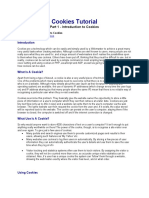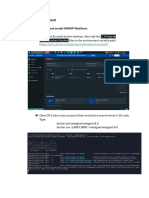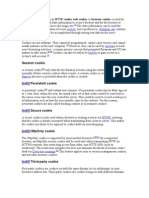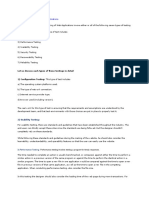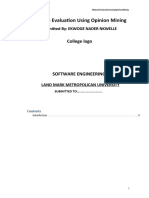29 WebApp Labs Introduction
29 WebApp Labs Introduction
Uploaded by
Bala GaneshCopyright:
Available Formats
29 WebApp Labs Introduction
29 WebApp Labs Introduction
Uploaded by
Bala GaneshCopyright
Available Formats
Share this document
Did you find this document useful?
Is this content inappropriate?
Copyright:
Available Formats
29 WebApp Labs Introduction
29 WebApp Labs Introduction
Uploaded by
Bala GaneshCopyright:
Available Formats
© 2018 Caendra, Inc.
| Hera for PTP | WebApp Labs - Introduction 1
© 2018 Caendra, Inc. | Hera for PTP | WebApp Labs - Introduction 2
In these Introduction labs, the student will learn some basic concepts on Same Origin
Policy and Cookies. Few different web applications are available to the student in order to
test and practice different implementations.
Once you are connected in VPN, you have to configure 10.100.13.37 (the lab DNS server)
as your first DNS resolver:
• WINDOWS: Change the IPv4 property of the TAP network device, adding 10.100.13.37 as the
first DNS server in the DNS settings.
• LINUX: Prepend an entry to the /etc/resolv.conf file with the IP address of the lab DNS server
10.100.13.37, ensuring it is the first nameserver listed.
You are now ready to open the following URL: http://info.introduction.site/ or navigate
http://10.100.13.37.
There are two types of lab: Video, Lab.
• Video section contains web applications used during video lessons. Therefore, if
you need any information about the scenario, the attacks and so on, please refer to
the corresponding video.
• Labs section contains web application where you can practice the techniques of the
specific module and have solutions. You can find them later in this manual
The main goal of these labs is to understand how the Same Origin Policy and Cookies work.
Navigate the web application and inspect how they behave.
The best tool is, as usual, your brain. Then you may need:
© 2018 Caendra, Inc. | Hera for PTP | WebApp Labs - Introduction 3
• Web Browser
• Firebug or a cookie inspector plugin
In order to test the cookie lab you will have to log into the application. Credentials are
already stored in the form. You can login by clicking on the “Sign in” button.
© 2018 Caendra, Inc. | Hera for PTP | WebApp Labs - Introduction 4
All the web applications contain a login page that the student can use to access the web
app. Notice that the forms are already filled with the correct credentials to log in, so you
just need to click on "Login".
As soon as you access the web application, depending on the web application, cookies will
be set with different configuration.
Log into the web applications and inspect the cookies: navigate different pages, domains
and subdomains in order to check when and where the cookies are sent.
• How cookies work depending on how they are set
© 2018 Caendra, Inc. | Hera for PTP | WebApp Labs - Introduction 5
Please go ahead only if you are really stuck or if you have
completed the labs
© 2018 Caendra, Inc. | Hera for PTP | WebApp Labs - Introduction 6
Once you click on the login button, the web application sets the following cookie:
• Name: TestCookie
• Value: Cookie set by default
• Domain: a.correctcookie1.site
• Path: /
• Expires: Session
The code that the application uses is the following:
setcookie("TestCookie", "Cookie set by default");
As you can see, everything is set by default, except the name and the cookie value. This
means that the cookie will only be sent to:
• http://a.correctcookie1.site/*
• https://a.correctcookie1.site/*
You can now test when the cookie is sent, by clicking on the links displayed in the page.
• Different path: the cookie is sent.
• Different subdomain: the cookie is not sent
• Different domain: the cookie is not sent
© 2018 Caendra, Inc. | Hera for PTP | WebApp Labs - Introduction 7
Once you click on the login button, the web application sets the following cookie:
• Name: TestCookie
• Value: Cookie set to correctcookie2.site
• Domain: .correctcookie2.site
• Path: /
• Expires: Session
The code that the application uses is the following:
setcookie("TestCookie", "Cookie set to correctcookie2.site",
null, null, "correctcookie2.site");
As you can see, the domain has been set to correctcookie2.site. This means that the cookie
will only be sent to:
• http://correctcookie2.site/*
• https://correctcookie2.site/*
• http://*.correctcookie2.site/*
• https://*.correctcookie2.site/*
You can now test when the cookie is sent, by clicking on the links displayed in the page.
• Different path: the cookie is sent.
• Different subdomain: the cookie is sent
• Different domain: the cookie is not sent
© 2018 Caendra, Inc. | Hera for PTP | WebApp Labs - Introduction 8
Once you click on the login button, the web application sets the following cookie:
• Name: TestCookie
• Value: Cookie set to /test/
• Domain: a.correctcookie3.site
• Path: /test/
• Expires: Session
The code that the application uses is the following:
setcookie("TestCookie", "Cookie set to /test/", null, "/test/");
As you can see, the path has been set to /test/. This means that the cookie will only be
sent to:
• http://a.correctcookie3.site/test/*
• https://a.correctcookie3.site/test/*
You can now test when the cookie is sent, by clicking on the links displayed in the page.
• Different path: the cookie is sent.
• Different subdomain: the cookie is not sent
• Different domain: the cookie is not sent
© 2018 Caendra, Inc. | Hera for PTP | WebApp Labs - Introduction 9
Once you click on the login button, the web application sets the following cookie:
• Name: TestCookie
• Value: Cookie value set to A for .correctcookie4.site
• Domain: .correctcookie4.site
• Path: /
• Expires: Session
The code that the application uses is the following:
setcookie("TestCookie", "Cookie value set to A for
.correctcookie4.site", null, null, ".correctcookie4.site");
As you can see, the domain has been set to correctcookie4.site. However, what
happens if the parent domain (correctcookie4.site) tries to set a cookie with the
same value?
To test this, you can click on "Set a new cookie from correctcoockie4.site". This is the code
used by the web application (correctcookie4.site/setnewcookie.php):
setcookie("TestCookie", "Cookie value set to B with a default
domain");
As you can see, now you have two cookies with the same name. Note that these two cookies
are different (inspect the domain value set).
© 2018 Caendra, Inc. | Hera for PTP | WebApp Labs - Introduction 10
The following web application does not set the cookie properly. Indeed once you click on
the login button, the web application sets the following cookie:
• Name: TestCookie
• Value: Cookie set for a.incorrectcookie.test
• Domain: .a.incorrectcookie.test
• Path: /
• Expires: Session
The code that the application uses is the following:
setcookie("TestCookie", "Cookie set for
a.incorrectcookie.test",null,null, "a.incorrectcookie.test");
As you can see, the domain has been set to a.incorrectcookie.test (but we are
navigating incorrectcookie.site).
This is not going to work since a.incorrectcookie.site cannot set a cookie for a
different domain (such as a.incorrectcookie.test). Indeed if we click on "Test
cookie on a.incorrectcookie.test", we can see that no cookie is set.
© 2018 Caendra, Inc. | Hera for PTP | WebApp Labs - Introduction 11
The following web application does not set the cookie properly. Indeed once you click on
the login button, the web application sets the following cookie:
• Name: TestCookie
• Value: Cookie set for b.incorrectcookie2.site
• Domain: b.incorrectcookie2.site
• Path: /
• Expires: Session
The code that the application uses is the following:
setcookie("TestCookie", "Cookie set for
b.incorrectcookie2.site",null,null, "b.incorrectcookie2.site");
As you can see, the subdomain has been set to b.incorrectcookie2.site (but we are
navigating a.incorrectcookie2.site).
This is not going to work since a.incorrectcookie2.site cannot set a cookie for a
subdomain (such as b.incorrectcookie2.site). Indeed if we click on "Test cookie on
b.incorrectcookie2.site", we can see that no cookie is set.
© 2018 Caendra, Inc. | Hera for PTP | WebApp Labs - Introduction 12
You might also like
- Authentication Bypassing Using WebGoat and BurpSuiteNo ratings yetAuthentication Bypassing Using WebGoat and BurpSuite8 pages
- Cookies: BY Aravind, Helvin M Geevar, Sowmya, Thamjeeth, SaranNo ratings yetCookies: BY Aravind, Helvin M Geevar, Sowmya, Thamjeeth, Saran18 pages
- How To Export Office 365 Mailboxes To PST Using EdiscoveryNo ratings yetHow To Export Office 365 Mailboxes To PST Using Ediscovery32 pages
- Website Cookie Testing, Test Cases For Testing Web Application Cookies?No ratings yetWebsite Cookie Testing, Test Cases For Testing Web Application Cookies?5 pages
- Course Notes For Unit 4 of The Udacity Course CS253 Web Application EngineeringNo ratings yetCourse Notes For Unit 4 of The Udacity Course CS253 Web Application Engineering29 pages
- How To Bypass Web Filters (Using Proxies, Etc)100% (11)How To Bypass Web Filters (Using Proxies, Etc)9 pages
- What Is A Cookie?: Cookie: A Small Amount of Information Sent by A Web Server To A Web Browser, Saved by The Browser, andNo ratings yetWhat Is A Cookie?: Cookie: A Small Amount of Information Sent by A Web Server To A Web Browser, Saved by The Browser, and7 pages
- Imageid, Imageurl, Imagedes: Dbcreation - PHP //connect To The Server Using The Correct Username and PasswordNo ratings yetImageid, Imageurl, Imagedes: Dbcreation - PHP //connect To The Server Using The Correct Username and Password39 pages
- Non Functional Testing of Web Applications: Let Us Discuss Each Types of These Testings in Detail100% (1)Non Functional Testing of Web Applications: Let Us Discuss Each Types of These Testings in Detail9 pages
- Evilginx - Advanced Phishing With Two-Factor Authentication BypassNo ratings yetEvilginx - Advanced Phishing With Two-Factor Authentication Bypass15 pages
- Imports: "Mycookiename" "Mycookievalue" "Mycookiename"No ratings yetImports: "Mycookiename" "Mycookievalue" "Mycookiename"5 pages
- My Project (Website Evaluation Using Opinion Mining)No ratings yetMy Project (Website Evaluation Using Opinion Mining)20 pages
- Public Fireeyes User Guide: Getting StartedNo ratings yetPublic Fireeyes User Guide: Getting Started10 pages
- Create a Website with Wordpress: 6 Easy Steps to Build a Professional Website from ScratchFrom EverandCreate a Website with Wordpress: 6 Easy Steps to Build a Professional Website from ScratchNo ratings yet
- Next - Js - Cli - MD at Canary Vercel - Next - JsNo ratings yetNext - Js - Cli - MD at Canary Vercel - Next - Js4 pages
- KFS-7111 Firmware Software Maintenance Release - FSR - FW1401 FCM - FW1601 SC - SW4010 - PDFNo ratings yetKFS-7111 Firmware Software Maintenance Release - FSR - FW1401 FCM - FW1601 SC - SW4010 - PDF3 pages
- El Secreto de Las Runas Guido Von List PDFNo ratings yetEl Secreto de Las Runas Guido Von List PDF2 pages
- Cmake Cheatsheet - A Gentle Introduction To Cmake100% (1)Cmake Cheatsheet - A Gentle Introduction To Cmake5 pages
- Installation Guide: Before Installing MIKE Powered by DHI Products, We Recommend That YouNo ratings yetInstallation Guide: Before Installing MIKE Powered by DHI Products, We Recommend That You2 pages
- RTU - ASCII Slave Test Software - Simply Modbus SoftwareNo ratings yetRTU - ASCII Slave Test Software - Simply Modbus Software4 pages
- Version History: Print Server: Ver.1.0.1.6No ratings yetVersion History: Print Server: Ver.1.0.1.62 pages
- Allocation Free Space Management Memory Mapped FilesNo ratings yetAllocation Free Space Management Memory Mapped Files25 pages
- Comstice Mobile Agent App For Cisco UCCX Configuration StepsNo ratings yetComstice Mobile Agent App For Cisco UCCX Configuration Steps8 pages
- Jetronix-Eco Software User Guide Rev1.1No ratings yetJetronix-Eco Software User Guide Rev1.114 pages
- Authentication Bypassing Using WebGoat and BurpSuiteAuthentication Bypassing Using WebGoat and BurpSuite
- Cookies: BY Aravind, Helvin M Geevar, Sowmya, Thamjeeth, SaranCookies: BY Aravind, Helvin M Geevar, Sowmya, Thamjeeth, Saran
- How To Export Office 365 Mailboxes To PST Using EdiscoveryHow To Export Office 365 Mailboxes To PST Using Ediscovery
- Website Cookie Testing, Test Cases For Testing Web Application Cookies?Website Cookie Testing, Test Cases For Testing Web Application Cookies?
- Course Notes For Unit 4 of The Udacity Course CS253 Web Application EngineeringCourse Notes For Unit 4 of The Udacity Course CS253 Web Application Engineering
- What Is A Cookie?: Cookie: A Small Amount of Information Sent by A Web Server To A Web Browser, Saved by The Browser, andWhat Is A Cookie?: Cookie: A Small Amount of Information Sent by A Web Server To A Web Browser, Saved by The Browser, and
- Imageid, Imageurl, Imagedes: Dbcreation - PHP //connect To The Server Using The Correct Username and PasswordImageid, Imageurl, Imagedes: Dbcreation - PHP //connect To The Server Using The Correct Username and Password
- Non Functional Testing of Web Applications: Let Us Discuss Each Types of These Testings in DetailNon Functional Testing of Web Applications: Let Us Discuss Each Types of These Testings in Detail
- Evilginx - Advanced Phishing With Two-Factor Authentication BypassEvilginx - Advanced Phishing With Two-Factor Authentication Bypass
- Imports: "Mycookiename" "Mycookievalue" "Mycookiename"Imports: "Mycookiename" "Mycookievalue" "Mycookiename"
- My Project (Website Evaluation Using Opinion Mining)My Project (Website Evaluation Using Opinion Mining)
- Create a Website with Wordpress: 6 Easy Steps to Build a Professional Website from ScratchFrom EverandCreate a Website with Wordpress: 6 Easy Steps to Build a Professional Website from Scratch
- KFS-7111 Firmware Software Maintenance Release - FSR - FW1401 FCM - FW1601 SC - SW4010 - PDFKFS-7111 Firmware Software Maintenance Release - FSR - FW1401 FCM - FW1601 SC - SW4010 - PDF
- Installation Guide: Before Installing MIKE Powered by DHI Products, We Recommend That YouInstallation Guide: Before Installing MIKE Powered by DHI Products, We Recommend That You
- RTU - ASCII Slave Test Software - Simply Modbus SoftwareRTU - ASCII Slave Test Software - Simply Modbus Software
- Allocation Free Space Management Memory Mapped FilesAllocation Free Space Management Memory Mapped Files
- Comstice Mobile Agent App For Cisco UCCX Configuration StepsComstice Mobile Agent App For Cisco UCCX Configuration Steps


